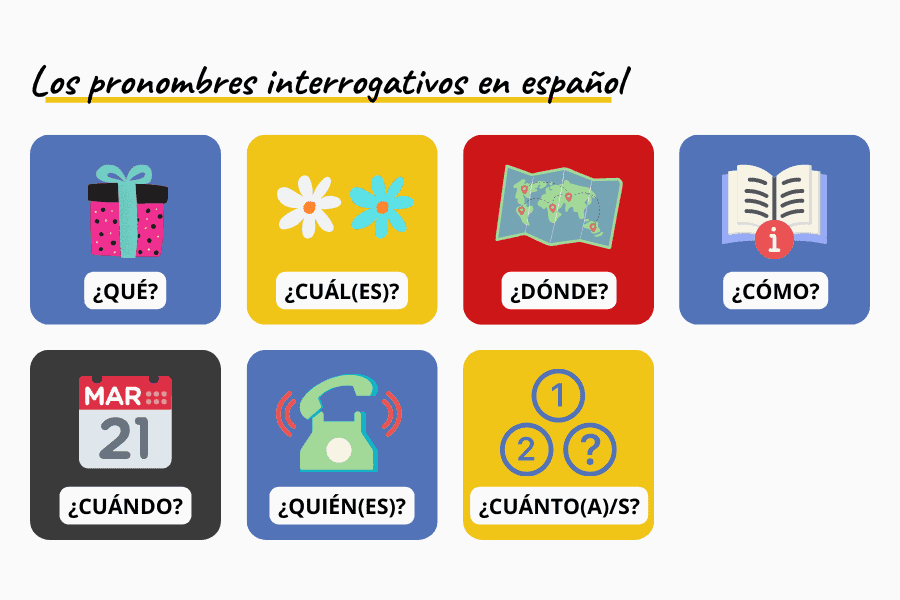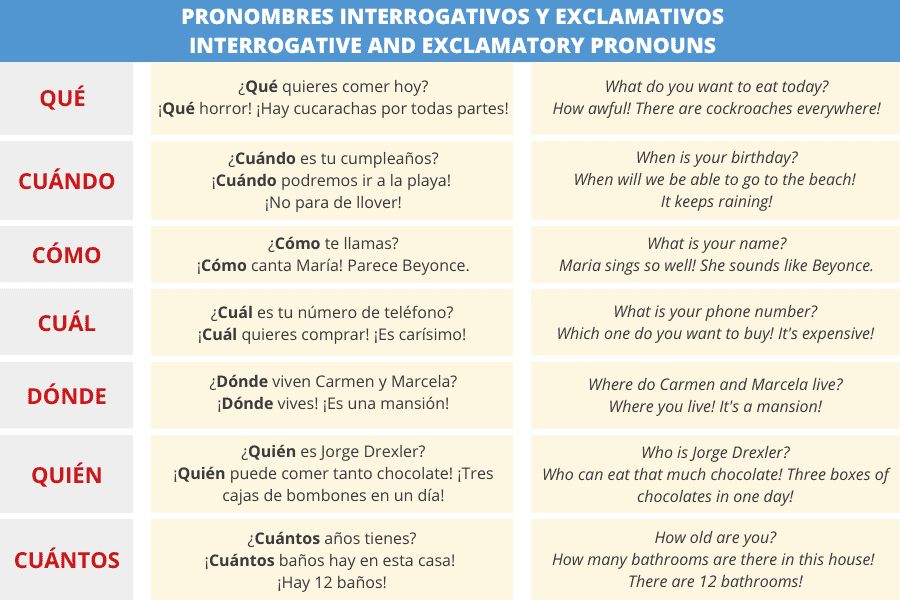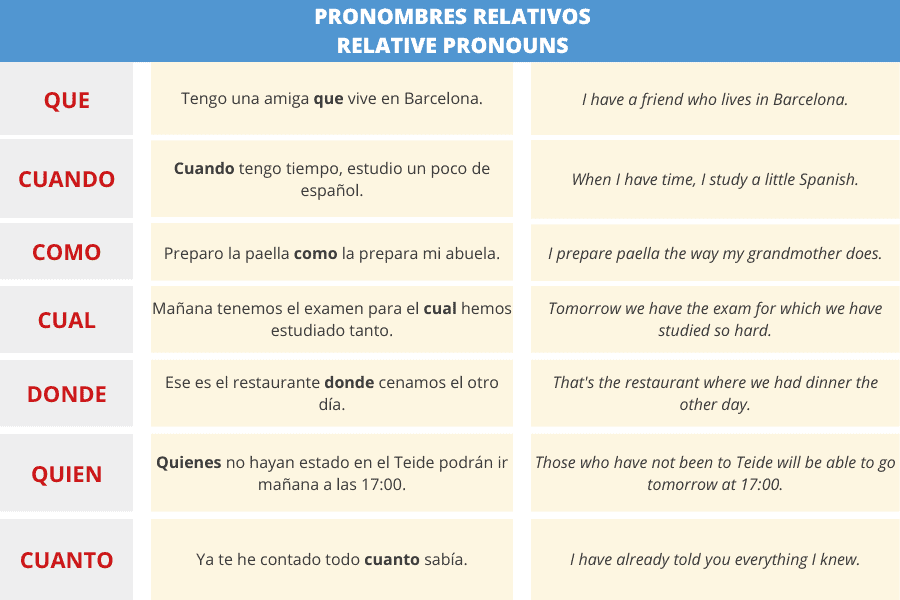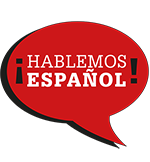Spanish Question Words

-
Save
This post includes:
- Grammar explanation
- Examples of sentences with question words
- Exercises to practice what you've learned
- Video with Carmen
Spanish Question Words
The Spanish expression goes that preguntando se llega a Roma (“by asking questions, one gets to Rome”), so asking questions is a fundamental part of being able to communicate with other people in any language.
But how can we ask questions in Spanish? Do we need a special order in sentences? How to correctly use Spanish question words? Do we have to use auxiliary verbs in Spanish? If you want to discover the answer to these and other questions, you are in the right place. Shall we start?
7 Spanish Interrogative Pronouns

-
Save
- [mp3j track= https://letsspeakspanish.com/wp-content/uploads/2022/11/Que_001.mp3 title="" ind="n" volslider="n" flow="y"] Qué - What
- [mp3j track= https://letsspeakspanish.com/wp-content/uploads/2022/11/Cual-_001.mp3 title="" ind="n" volslider="n" flow="y"] Cuál(es) - Which
- [mp3j track= https://letsspeakspanish.com/wp-content/uploads/2022/11/donde_001.mp3 title="" ind="n" volslider="n" flow="y"] Dónde - Where
- [mp3j track= https://letsspeakspanish.com/wp-content/uploads/2022/11/Como_001.mp3 title="" ind="n" volslider="n" flow="y"] Cómo - How
- [mp3j track= https://letsspeakspanish.com/wp-content/uploads/2022/11/Cuando_001.mp3 title="" ind="n" volslider="n" flow="y"] Cuándo - When
- [mp3j track= https://letsspeakspanish.com/wp-content/uploads/2022/11/Quienes_001.mp3 title="" ind="n" volslider="n" flow="y"] Quién(es) - Who
- [mp3j track= https://letsspeakspanish.com/wp-content/uploads/2022/11/Cuantoa_s_001.mp3 title="" ind="n" volslider="n" flow="y"] Cuánto(a)/s - How much/many
Differences between Spanish and English
First thing we notice when we see questions in Spanish is this sign “¿” that is completely unknown in other languages. Spanish is the only language that needs to mark where the question begins and ends.
Cómo te llamas? 🆇 ¿Cómo te llamas? ✅ (What is your name?)
Eres italiana? 🆇 ¿Eres italiana? ✅ (Are you Italian?)
Thanks to this sign we can read the questions with the correct intonation from the beginning.
Interrogatives with a Written Accent (´)
The written accent is very important in Spanish, but why do we sometimes write the same word with or without an accent? QUÉ or QUE? Which is the correct option? What does it depend on?
Qué, cuándo, cómo, cuál(es), dónde, quién(es), cuánto(a)/s always have a written accent when they are interrogative pronouns, in other words, when we use them to ask a question. Here are some examples:
They are also written with an accent when they are used to exclaim (exclamatory pronouns):

-
Save
Qué, cuándo, cómo, cuál(es), dónde, quién(es), cuánto(a)/s don’t have an accent in relative clauses. These sentences are not questions or exclamations. Have a look at these examples:

-
Save
Practice the use of accents in Spanish questions
Qué vs. Cuál(es)
What vs. Which one(s)
Spanish students’ eternal question: QUÉ or CUÁL? It’s very simple. Take a look at this chart and learn the rules.

-
Save
💡Attention:
CUÁL(ES) + noun is NOT correct:
¿Cuál camiseta vas a comprar? 🆇 (Which T-shirt are you going to buy?)
Before a noun we use QUÉ:
¿Qué camiseta vas a comprar? ✅ (Which T-shirt are you going to buy?)
If we use the interrogative pronoun QUÉ in this type of question we want to know the meaning of something and not to identify it. The answer is a definition.
We use QUÉ to:

-
Save
- ¿Qué necesitas? - What do you need?
- Una silla. - A chair.

-
Save
- ¿Qué hacemos esta tarde? - What are we doing this afternoon?
- ¿Vemos una película? - Shall we watch a movie?

-
Save
- ¿Qué idiomas hablas? - What languages do you speak?
- Hablo español, catalán, gallego y euskera. - I speak Spanish, Catalan, Galician and Basque.

-
Save
- Miriam, ¿y tú qué haces? - Miriam, what do you do for a living?
- Yo soy periodista. - I am a journalist.
We use CUÁL(ES) + verb to:
1. Identify an element within a group of the same category:

-
Save
- ¿Cuál prefieres: la camisa azul o la verde?- Which shirt do you prefer: the blue one or the green one?
- Prefiero la verde. Es más bonita. - I prefer the green one. It is nicer.

-
Save
- ¿Cuál es tu coche? - Which is your car?
- Ese blanco que está ahí. - That white one that is there.
💡Attention:
CUÁLES is the plural form of CUÁL. We use the plural CUÁLES when we ask for a plural noun.

-
Save
- ¿Cuáles son mejores: los deportes de equipo o los deportes en solitario? - Which are better: team sports or solo sports?
- Los mejores son los deportes de equipo. Me encanta jugar al fútbol. - The best are team sports. I love playing soccer.

-
Save
- He visitado muchos países de Hispanoamérica. - I have visited many countries in Latin America.
- ¿Ah, sí? ¿Cuáles? - Oh yeah? Which ones?
- Uruguay, Perú, Argentina,y Panamá. - Uruguay, Peru, Argentina and Panama.
Look at these two examples from the dialogue above:
- ¿Cuáles son mejores? → We use CUÁLES because we are asking about "sports" (plural noun).
- ¿Ah, sí? ¿Cuáles? → We use CUÁLES because we are asking about "countries" (plural noun).
Try this exercise on the use of QUÉ and CUÁL(ES)
Por qué vs. Porque
Why vs. Because

-
Save
- ¿Por qué no tienes los deberes? - Why don't you have your homework?
- Porque mi perro se los comió. - Because my dog ate it.

-
Save
- No entiendo por qué no te gusta el golf. - I don't understand why you don't like golf.
- No me gusta el golf porque es aburrido. - I don’t like golf because it’s boring.
- ¿Aburrido? ¡Qué dices! A mí me encanta porque es muy relajante. - Boring? What are you talking about! I love it because it's very relaxing.
💡Attention:
There is also PORQUÉ (together and with an accent). It’s a noun that is equivalent to ‘the reason’ or ‘the motive’.
For example:
Es muy difícil saber el porqué de su enfado.
(la razón)
(It is very difficult to know the reason for his anger.)
Test your new skills!
De dónde vs. Dónde
From where vs. Where
We use both to ask about places, but the preposition DE makes an important difference.
We use DE DÓNDE to:
1. Ask about the origin, provenance or nationality of people, objects and animals.
- ¿De dónde son Carlos y Carolina? - Where are Carlos and Carolina from?
- Ellos son de Lisboa. - They are from Lisbon.
- ¡Me encanta esa mesa! ¿De dónde es? - I love that table! Where is it from?
- Es de Ikea. - It's from Ikea.
- ¿De dónde venís tan tarde? - Where are you coming from so late?
- Venimos de la fiesta de Martina. - We come from Martina’s party.
We use DÓNDE to:
1. Ask for the location of people, objects, animals and places.

-
Save
- ¿Dónde viven tus padres? - Where do your parents live?
- Mis padres viven en Arafo, un pueblo pequeño en el este de Tenerife. - My parents live in Arafo, a small town in the east of Tenerife.

-
Save
- ¿Dónde has comprado esa chaqueta? - Where did you buy that jacket?
- La he comprado en un mercadillo de segunda mano. ¡Es vintage! - I bought it at a flea market. It's vintage!

-
Save
- ¿Dónde están los perros? - Where are the dogs?
- Los perros están en el parque con Lorenzo. - The dogs are in the park with Lorenzo.
Adónde vs. A dónde
Where vs. Where to
We use ADÓNDE and A DÓNDE to ask for an address or a destination. Both options are correct and are used in the same way.

-
Save
- Oye, María. ¿A dónde vamos a cenar esta noche? - Hey, Maria, where are we going for dinner tonight?
- Pues no lo sé. Podemos ir al restaurante peruano. - I don't know. We can go to the Peruvian restaurant..

-
Save
- ¿Adónde se dirige este tren? - Where is this train going?
- Este tren va a Barcelona y pasa por Valencia. - This train goes to Barcelona and passes through Valencia.
Therefore, you can use ADÓNDE and A DÓNDE in the same cases:
¿A dónde vamos a cenar esta noche? = ¿Adónde vamos a cenar esta noche?
¿A dónde se dirige este tren? = ¿Adónde se dirige este tren?
Let's try this exercise!
A quién vs. Quién
To whom vs. Who
QUIÉN is used to ask about the identity of people.

-
Save
- ¿Quién es tu profesora de español? - Who is your Spanish teacher?
- ¿Quién vino ayer a casa?- Who came home yesterday?
- ¿Quién se ha comido el último helado de chocolate? - Who has eaten the last chocolate ice cream?
We use QUIÉNES when we ask for more than one person.

-
Save
- ¿Quiénes son esos? - Who are they?
- Son Cristóbal y Sara, unos compañeros de clase. - They are Cristobal and Sara, some classmates.

-
Save
- ¿Quiénes van a ir a la fiesta de Carolina? - Who is going to Carolina’s party?
- María, Paula y yo. - Maria, Paula and I.
💡Attention:
QUIÉN(ES) can only be used with people.
For objects we use QUÉ.
We use A QUIÉN(ES) to:
1. When a person is the Direct Object.
- ¿A quién has visto este fin de semana? - Who have you seen this weekend?
- Este fin de semana he visto a mi amiga Leanne. - I’ve seen my friend Leanne this weekend.
💡Important:
Remember that the direct object of a person needs the preposition A.
Yo veo la televisión. (I watch television.)
Yo veo a Martina. (I see Martina) → direct object of person
No conocemos Madrid. (We don’t know Madrid.)
No conocemos a tu madre. (We don’t know your mother) → direct object of person
2. When we ask for the Indirect Object or Indirect Object complement.
- ¿A quiénes compras regalos por Navidad? - Who do you buy gifts for at Christmas?
- Normalmente solo compro regalos a mi familia y a mi novia. - I usually only buy gifts for my family and my girlfriend.
💡Attention:
In the indirect object case, we use the preposition A also with objects, but we only use A QUIÉN(ES) when we ask about people.
- Ya le he puesto sal a la sopa. - I've already salted the soup.
- ¿A quién le has puesto sal? ¿A tu abuelo? - Whom did you add salt to? Your grandfather?
- A quién no, abuela, a qué. A la sopa. - Not to whom, grandma, to what. The soup.
Practice!
How to Ask Questions?
When the normal order of the sentence and auxiliary verbs are changed in another language, it can be a real nightmare. However, in Spanish it’s quite simple. It’s a more flexible language when it comes to asking questions and intonation becomes the key part.
When there are no interrogative pronouns, we can maintain the normal order of the enunciative sentences (affirmative or negative).
- Eres española. - You are Spanish.
- ¿Eres española? - Are you Spanish?
- No queréis ir al concierto. - You don’t want to go to the concert.
- ¿No queréis ir al concierto? - Don't you want to go to the concert?
When there is an interrogative pronoun, this pronoun has to initiate the question.
- ¿Dónde vamos a ir de vacaciones este verano? - Where are we going on vacation this summer?
- ¿Cuándo llegaste de la oficina el viernes pasado? - When did you get home from the office last Friday?
- ¿Cómo se llama usted? - What is your name?
From the examples, we see that in Spanish the use of the explicit subject is optional. This means that we have two options:
yo soy arquitecta = soy arquitecta. (I am an architect.)
- ¿Tú eres española? - Are you Spanish?
- ¿Juanjo y tú no queréis ir al concierto? - Don't you and Juanjo want to go to the concert?
On the contrary, when there is an interrogative pronoun, we need to put the subject after the verb:
- ¿Dónde vamos a ir Carolina y yo de vacaciones este verano? - Where are Carolina and I going on vacation this summer?
- ¿Cuándo llegaste tú de la oficina el viernes pasado? - When did you get home from the office last Friday?
- ¿Cómo se llama tu amiga? - What is your friend's name?
Now that we finally understand how to ask questions in Spanish and how to use interrogative pronouns we have to face the final enemy: indirect questions.
The first thing we need to know is that there are two basic types of questions: direct questions and indirect questions.

-
Save
- ¿Quién quiere ir esta noche al nuevo restaurante italiano? - Who wants to go to the new Italian restaurant tonight?
- Nosotras nos apuntamos, pero no sabemos dónde está. - We're in, but we don't know where it is.
- Vale. Es muy fácil. ¿Conocéis el barrio de Chueca? - Okay. It is very easy. Do you know the neighborhood of Chueca?
- Un poco. - A little bit.
- ¿Habéis estado en el mercado de San Ginés? - Have you been to the San Gines market?
- Sí, pero yo no recuerdo cómo llegar. - Yes, but I don't remember how to get there.
Several examples of both types of questions appear in the conversation above. Look:
¿Quién quiere ir esta noche al nuevo restaurante italiano?
¿Conocéis el barrio de Chueca?
¿Habéis estado en el mercado de San Ginés?
→ Direct questions
…no sabemos dónde está.
Yo no recuerdo cómo llegar.
→ Indirect questions
Direct Questions
Direct questions are those we write between question marks (¿?).
¿Conocéis el barrio de Chueca?
Indirect Questions
Indirect questions do not have interrogative signs.
These are verbs that introduce indirect questions: decir (to say), saber (to know), preguntar (to ask), recordar (to remember), comprender (to understand),…
- Sí, pero yo no recuerdo cómo llegar. (Yes, but I don’t remember how to get there.)
- Vamos a explicar cuándo necesitamos usar la tilde. (Let’s explain when we need to use the written accent.)
- Yo no recuerdo cómo llegar. - I don't remember how to get there.
- Voy a explicar cuándo necesitan usar la tilde.- I'm going to explain when you/they need to use the written accent.
- Irene no comprende por qué no fuimos a la playa. - Irene doesn't understand why we didn't go to the beach.
And the last one...
Congratulations! It’s been a long one… Now that you have all the information, you can form the Spanish questions correctly.
I hope you were able to see the differences between the questions words, so now, ask us a question!

-
Save
Would you like to take your Spanish to the next level?
Whether you’re a complete beginner or you’re an advanced student, with us you’ll reach the next level of Spanish quickly and easily. With 24 Levels to Spanish fluency, the next level is always close by, so you will never lose motivation.
You can choose between:
In both cases, you’ll learn Spanish using our successful 24 Level System to Spanish Fluency® and our unique Spanish teaching methods.

-
Save











